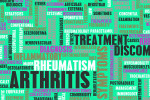

Arthritis, a joint disorder that involves inflammation of one or more joints, is a common ailment to those  of age 65 or older. In 2013, 1 in every 5 American adults was diagnosed with some form of arthritis. There are over 100 different types of arthritis but the common three are osteoarthritis, rheumatoid arthritis and gout.
of age 65 or older. In 2013, 1 in every 5 American adults was diagnosed with some form of arthritis. There are over 100 different types of arthritis but the common three are osteoarthritis, rheumatoid arthritis and gout.
Osteoarthritis
The most common type of arthritis, osteoarthritis is a degenerative joint disease, which involves the degradation of joint cartilage and its underlying bone. Symptoms include sore or achy joints, stiffness, bone enlargements in the middle and end joints of fingers, loss of flexibility and joint swelling. When the cartilage that cushions the end of the bones in your joints deteriorates, it causes the bones to rub against one another. This is what causes osteoarthritis. Currently there is no known cure or prevention for osteoarthritis, but certain measures can be taken to keep your pain levels low and help you maintain joint movement.
Rheumatoid Arthritis
This form of arthritis is a chronic inflammatory disorder that usually affects the small joints in your hands and feet. It affects about one-tenth as many people as osteoarthritis. Some symptoms between the two are similar, such as swollen joints and morning stiffness, but the two are quite different in many other ways. Unlike osteoarthritis, which is caused by the daily wear and tear on joints, rheumatoid arthritis happens when your body’s immune system mistakenly attacks your own body’s tissues. In addition to the symptoms it shares with osteoarthritis, rheumatoid arthritis also has whole-body symptoms such as frequent fatigue and an overall ill feeling. Those suffering from rheumatoid arthritis are more susceptible to osteoporosis, heart problems, lung disease and carpal tunnel.
Currently there’s no way to prevent rheumatoid arthritis, or cure it once it has developed, but if you catch it early enough, you can stop it or slow it down through aggressive treatments.
Gout
This form of arthritis presents itself as a sudden attack of pain, swelling, redness, and stiffness, usually in one joint. It happens because of too much uric acid in a joint, and is usually caused by conditions related to diet, medicines that increase uric acid concentration, certain medical conditions and surgery. Resting the affected joint, using ice to reduce swelling and taking short-term medicine, can treat an acute gout attack. Long-term gout can be managed and prevented as well by exercising, eating healthy and taking long-term medication.
Although most forms of arthritis can’t be cured or prevented, you many be able to relieve its symptoms. We’ve listed some great ways to help manage your arthritis symptoms below:
Manage Your Weight
Give your joints some relief by taking off some of the pressure. Losing weigh can help reduce the stress on your joints, decrease your pain, and prevent future damage to your joints.
Exercise
Doing low-impact exercises such as yoga, tai chi, or water aerobics can help you manage your weight and maintain flexibility in your joints.
Acupuncture
Many have found that acupuncture has helped reduce their arthritic pain, through relaxing muscles and regulating their bodies’ nervous system.
Power Up with Omega-3
The omega-3 fatty acids found in fish and fish oil supplements can help reduce joint stiffness and pain by turning off signals to your body that start the inflammatory process.
Turmeric
Studies have shown that the spice turmeric has great anti-inflammatory properties, as well as having many other health benefits. It has been used for 4,000 years in Ayurvedic and Chinese medicine. Taking it could help reduce arthritis pain. You can get it as a spice at the grocery or health food store, or in capsules.
If you think you may have arthritis, make an appointment with your doctor today. To read more about arthritis visit the National Institute of Arthritis and Musculoskeletal and Skin Diseases or the Arthritis Foundation’s websites.
Author: Kimberly Recor, staff writer at Designing Brighter Tomorrows
© 2014 Designing Brighter Tomorrows, Inc.
This site is for information only, and is for your voluntary use at your own risk. See Terms of Use